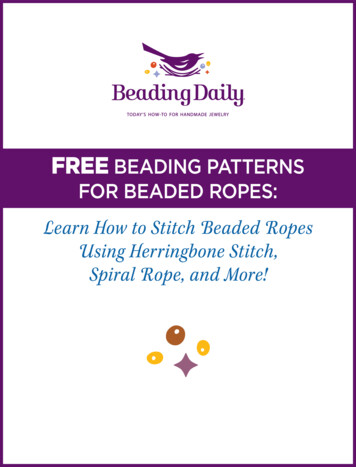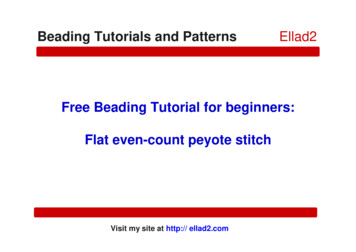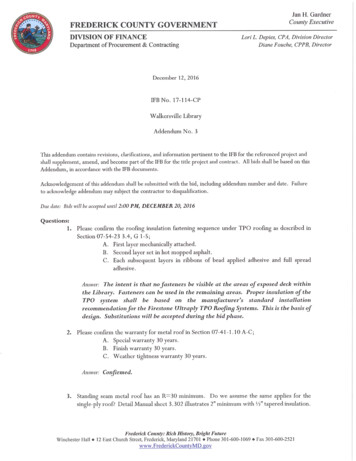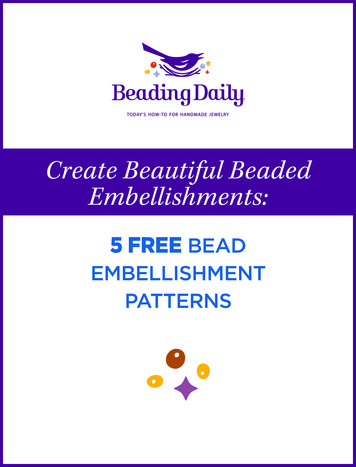
Transcription
FREE BEADING PATTERNSFOR BEADED ROPES:Learn How to Stitch Beaded RopesUsing Herringbone Stitch,Spiral Rope, and More!
FREE BEADING PATTERNS FOR BEADED ROPES:Learn How to Stitch Beaded Ropes Using Herringbone Stitch, Spiral Rope, and More!OMEGA CONNECTORMAGGIE’S WEAVEby SHARON BATEMAN p. 4by MARLENE BLESSING p. 7AEGEAN SEAEYE OF THE PEACOCK LARIATSATIN SPIRALS BRACELETby SCARLETT LANSON p. 9by KERRIE SLADE p. 13by JULIE D’AMICO-BERES p. 16TECHNIQUES p. 18 F W MEDIA, INC. ALL RIGHTS RESERVED. F W MEDIA GRANTS PERMISSION FOR ANY OR ALL PAGES IN THIS ISSUE TO BE COPIED FOR PERSONAL USE. BEADINGDAILY.COMpage 2
FREE BEADING PATTERNS FOR BEADED ROPES:Learn How to Stitch Beaded Ropes Using Herringbone Stitch, Spiral Rope, and More!in a beaded rope made of this stitch. Accented withhandmade glass lampwork beads, this earthy fashionforward necklace can be designed to suit any taste oroccasion.For most of us, our introduction to beaded ropes cameby way of making tubular versions of our favorite off-loombead-weaving stitches, or by creating a classic spiral rope.There’s something incredible about watching a few roundsof bead stitching turn into a fabulous beaded rope. The classic spiral rope pattern gets a whole newfunky turn in Scarlett Lanson’s Aegean Sea lariat. Thiscleverly embellished spiral rope can be worn a numberof different ways, and the brass focal ring is a classicdesign element for modern beaded jewelry.Beaded ropes have come a long way in the last few years,evolving from a simple solution for hanging a beadedpendant or making a simple beaded bracelet to becomingstand-alone works of wearable beaded art. Beadedropes can be made from just about any off-loom beadweaving stitch, including right-angle weave, peyote stitch,herringbone stitch, square stitch, or brick stitch. Working atubular form of any off-loom bead-weaving stitch will giveyou a beaded rope that’s unique and just full of possibilitiesfor embellishing!Adding beaded embellishments to your beaded ropes ishalf the fun of creating with these tubular bead-weavingstitches. Whether you prefer to include pearls and crystals,tiny glass beads, or even more seed beads of varying sizesand shapes, you can create unique beaded rope projectsfor any occasion. Take a look at these five free beadingprojects that we’ve chosen to get you started playing andexperimenting with beaded ropes! Learn how to finish any beaded rope with a clever wireending when you stitch up the Omega Connector bySharon Bateman. The project itself is shown with anAfrican Helix beaded rope, but you can easily adaptthis technique to any beading stitch you like. I f you love color, you’ll be thrilled to stitch up KerrieSlade’s Eye of the Peacock lariat, using an easytwisted herringbone rope to support two fun peacock“feathers”. Crystal rings and Lapis gemstone beadsmake this a bold beaded necklace project. Finally, the Satin Spirals Bracelet by Julie D’AmicoBeres puts a fun spin on easy spiral rope. Using brightlycolored Czech fire polished beads and crystal pearls,this beaded bracelet is the perfect playground for yourwhimsically-shaped clasps!So the next time you need a fun beading project toexercise your creativity and practice your favorite tubularbead-weaving stitches, look no further than a beaded rope!What will you create with your beaded rope?Bead Happy, Herringbone stitch is always a popular way to make abeaded rope, and Maggie’s Weave by Marlene Blessingshows just how easy it is to create patterns and textureFree Beading Patterns for Beaded Ropes: Learn How to Stitch Beaded Ropes Using Herringbone Stitch, Spiral Rope, and More!editor, beadingdaily JENNIFER VANBENSCHOTENproduction designer JANICE TAPIA / photography JOE COCA, ANN SWANSONProjects and information are for inspiration and personal use only. BeadingDaily, Beadwork, and Stringing do not recommend, approve, or endorse any of theadvertisers, products, services, or views advertised in this publication. Nor do BeadingDaily, Beadwork, or Stringing evaluate the advertisers’ claims in any way. Youshould, therefore, use your own judgment in evaluating the advertisers, products, services, and views advertised in BeadingDaily, Beadwork, and Stringing. F W MEDIA, INC. ALL RIGHTS RESERVED. F W MEDIA GRANTS PERMISSION FOR ANY OR ALL PAGES IN THIS ISSUE TO BE COPIED FOR PERSONAL USE. BEADINGDAILY.COMpage 3
OmegaConnectorSharon BatemanCleverly hidden wirework tobegin and end any beaded tube.This wire and bead connector makes adding a clasp much simpler and also reduces wear on the threads atthe ends of a necklace. It is designed for any seed bead project that forms a hollow tube. The necklaceshown here uses a helix tube, but you can begin peyote, herringbone, or netted tubes in the same way, andincrease them to any diameter you like. After the base tube is made, embellish it with a focal bead and freeformnetting and peyote stitches to turn a choker into a living landscape.AFRICAN HELIX TUBEMaterialsTwo 4" gold wiresSize 11 black and copper-lined seed beadsTwo 4mm round beadsFocal bead, pendant, or button6mm accent beadsSize D beading thread to complement bead colorJump ringsClaspStep 3: Slide the circle of beads onto the beaded wire.Hold onto the long end of the wire and work ahelix by stringing 2 black and 3 copper beads andpassing under the thread between the next 2 beads(Figure 1). Pull the thread tight. Work around thecircle, stringing 5 beads and passing under thethread between the next 2 beads.NotionsFigure 1Beading needleWire cutterRound-nose pliersStep 1: Using the round-nosed pliers, bend a doubleloop at one end of the 4" wire. Slide one of the4mm beads onto the wire. Repeat on the secondwire.Step 2: Using a yard of thread and a needle, string 4black size 11 . Pass through all again and tie aknot. Trim the tail. F W MEDIA, INC. ALL RIGHTS RESERVED. F W MEDIA GRANTS PERMISSION FOR ANY OR ALL PAGES IN THIS ISSUE TO BE COPIED FOR PERSONAL USE. BEADINGDAILY.COMpage 4
Step 4: String 5 beads (2 black and 3 copper) and passunder the thread between the second and thirdbeads of each set (Figure 2). Pull tight. Repeat thisstep, working on all the sets until you have 1" ormore in length.Figure 2into the tube. Pull the thread tight around theconnector. Pass through the third bead of each setagain and tie off your thread.Step 7: String a decorative bead onto the wire andmake the loop as in Step 5. Add jump rings and aclasp to complete the necklace.FreeForm embellishingStep 8: Add the centerpiece bead along the center sur-Step 5: Turn your work upside down, so the unfin-ished end of the wire is up. String a decorativepressed glass, 6mm, or crystal onto the wire. Usethe round-nose pliers to make a loop on the endand trim the excess wire. This will form a link foryour clasp.Step 6: Work the length of your necklace. When youwant to end it, pass back up through the last 3beads added. Pass through the third bead of eachset around the tube, but do not pull closed. Pushthe bead end of your second wire connector downface of the necklace rope, sewing it down by running through the beads. Use freeform netting and/or peyote to add embellishments as desired. If youare making bat wings or spider webs or whatever—begin netting (see Techniques, page 18)with 5 black beads per stitch along a section of therope, stitching through single beads across theouter spiral of the helix. Continue netting with 5beads per stitch to make a 1" triangle. Work peyote stitch (see Techniques, page 18) up one side ofthe netting to desired length (Figure 3). Work asecond layer of netting and peyote to add morefreeform texture and color.Sharon Bateman lives in Northern Idaho and has been beadingprofessionally since the early nineties. She can be reached for questions orcomments at www.sharonbateman.com.Resource for focal tagua nut carved bead:Red Horse Ranch, 25051 Buckskin Drive, Laguna Hills, CA92653; (949) 831-1316.Figure 3 F W MEDIA, INC. ALL RIGHTS RESERVED. F W MEDIA GRANTS PERMISSION FOR ANY OR ALL PAGES IN THIS ISSUE TO BE COPIED FOR PERSONAL USE. BEADINGDAILY.COMpage 5
BEADWORKOctober/November 2002 F W MEDIA, INC. ALL RIGHTS RESERVED. F W MEDIA GRANTS PERMISSION FOR ANY OR ALL PAGES IN THIS ISSUE TO BE COPIED FOR PERSONAL USE. BEADINGDAILY.COMpage 627
maggie’s weaveMarlene BlessingNamed for the designer’s GrandmaMaggie, this necklace was inspiredby the graphics in JoAnne Zekowski’slampworked beads. This fashion-forwardpiece combines her spectacular beads withherringbone-stitched tubes,silver beads, and chain.techniques:: ladder stitch:: herringbonestitch:: stringing:: crimping:: wireworkingSee p. 18 for helpfultechnique information. F W MEDIA, INC. ALL RIGHTS RESERVED. F W MEDIA GRANTS PERMISSION FOR ANY OR ALL PAGES IN THIS ISSUE TO BE COPIED FOR PERSONAL USE. BEADINGDAILY.COMpage 7
Materials1) Tubes. Use size 11 seed beads towork 2 herringbone-stitched tubes:Use 6' of thread to work a stripof ladder stitch 6A long, leaving a4" tail. Stitch the first and last beadstogether to form a ring (Fig. 1).Round 1:Fig. 1: Round 1Work tubular herringbonestitch off the previous round, usingthis color sequence to create a horizontally striped tube: A, B, C, B, C, B,C, B, C, B, C, B, C, B, C, A, A, C, B,C, A, A, C, B, C, B, C, B, C, B, C, B,C, B, C, B, and A.Rounds 39–113: Repeat Rounds 2–38twice. Work 1 round using A. Securethe thread and set aside.Repeat entire step for a second tube.Rounds 2–38:2) Focal pendanT. Use the 20-gaugewire to form a simple loop. String thesize 6 bead, the 10 5mm rondelle, the17 8mm rondelle, the 18 14mm cone,the 23 10mm rondelle, and the19 3mm disc; form a wrapped looplarge enough to accommodate the rollochain (Fig. 2). Set aside.3) necklace. Use 12" of beading wireto string 1 crimp tube and one end of therollo chain; pass back through the tubeand crimp. Cover the tube with 1 crimpcover. String 1 black disc, the 12 6mmrondelle, 1 black disc, 1 basket-weavetube, 1 black disc, 1 herringbone-stitchedtube, 1 black disc, 1 basket-weave tube,1 black disc, 1 crimp tube, and one half ofthe clasp. Pass back through the tube,crimp, and cover. Use the rollo chain tostring the focal pendant’s wrapped loop.Beginning on the free end of the rollochain, repeat entire step using the14 7mm rondelle in place of the12 6mm rondelle and the other half ofthe clasp. MaRlene blessing is editorial director for Beadwork magazine. she is also a frequent presenter onthe pBs-tV show Beads, Baubles, and Jewels, as wellas the coauthor of four titles in the Create Jewelryseries from interweave Books.ResouRcescheck your local bead shop or contact:seed beads: Beyond Beadery, (800) 8405548, www.beyondbeadery.com. pressedglass discs: raven’s Journey international,www.theravenstore.com. lampworked beads:Joanne Zekowski, (706) 468-9543, zdesigns@mindspring.com. Basket-weave tubes:singaraja imports, (800) 865-8856, www.singarajaimports.com. similar clasp: ninaDesigns, (800) 336-6462, www.ninadesigns.com. Chain and nymo beading thread:FusionBeads.com, (888) 781-3559.3 g chocolate opaque size 11 seed beads (a)5 g mocha opaque size 11 seed beads (B)5 g matte metallic iris gray size 11 seedbeads (C)1 matte dark gray size 6 seed bead10 black 8 3mm pressed-glass discs1 black/gray 10 5mm lampworked rondelle1 taupe 12 6mm lampworked rondelle1 taupe/light taupe 14 7mm striped lampworked rondelle1 taupe/light taupe 17 8mm striped lampworked rondelle1 taupe/metallic/black 18 14mm bumpylampworked cone1 metallic gray 19 3mm swirled lampworked disc1 taupe/brown/olive 23 10mm dottedand-striped lampworked rondelle4 sterling silver 8 26mm basket-weavetubes1 sterling silver 7 13mm hook clasp with2 decorative 5 15mm tube links and 1" of5mm round extender chain4 sterling silver 2mm crimp tubes4 sterling silver 3mm crimp covers2" of sterling silver 2mm rollo chaingray nylon beading thread4" of sterling silver 20-gauge wire24" of .018 beading wiretoolsscissorssize 11 beading needleWire cuttersChain-nose pliersround-nose pliersFinished size: 23¾"(adjustable to 24¾")artist’s tipsWhen starting a herringbonestitched tube, you may find it easiest to work over a knitting needleor the handle of a paintbrush forthe first several rounds.If you desire stiffer tubes, firststring size 11 seed beads (or aslarge as your tube will accommodate) onto your beading wire, thenslip the tube over the seed beads.Fig. 2: Focal pendant F W MEDIA, INC. ALL RIGHTS RESERVED. F W MEDIA GRANTS PERMISSION FOR ANY OR ALL PAGES IN THIS ISSUE TO BE COPIED FOR PERSONAL USE. BEADINGDAILY.COMpage 8
aegeanseaA Mediterranean paletteof bronze, blue, and lime iswoven into a beaded collageof copper, brass, seed beads,crystals, pearls, and pyrite.Thread the two lariat ropesthrough the embellished brassring to display a beautifulconfluence of color and texture.Scarlett LansonfTECHNIQUES::::::::::ARTIST’S TIPbrick stitchpicotspiral ropefringepeyote stitchFeel free to work sections withtechniques other than thoseused here. It’s a collage, so youcan explore other stitches andmaterials to make a piece thatis uniquely you.See p. 18 for helpful techniqueinformation. F W MEDIA, INC. ALL RIGHTS RESERVED. F W MEDIA GRANTS PERMISSION FOR ANY OR ALL PAGES IN THIS ISSUE TO BE COPIED FOR PERSONAL USE. BEADINGDAILY.COMpage 9
F OC AL1) EMBELLISHED RING. Use 3' ofBeading a CollageThis piece began with a smattering of copper, brass,bronze, and pyrite spread across two bead mats,competing for my attention and pleading to be part ofthis project. I set out to make a beaded collage, something thatcould tie all of these elements together without clashing.Combining these mediums with beadweaving produces a piecewith a lovely weight to it. One of the first necklaces I everdesigned was in this style, a lariat with two very long ropes thatwrapped around the neck and flowed through a pendant in thecenter. With the addition of freshwater pearls, crystals, and seedbeads in blue, bronze, and green, I was able to assemble thispiece—an earthy and textural creation that reminded me of aGrecian goddess and mixed the metals beautifully.thread to brick-stitch a crown of seedbeads onto the filigree ring, creating theend of the lariat:Crown: Leaving a 4" tail, anchor thethread at the outside edge of the ring.String 1E, *1C, 1A, 1C, and 1E; passthrough an opening in the filigreering, about 1 8 " from where you lastexited, and back up through the last Estrung. Repeat around from * to add atotal of 18E. Connect the first and lastE with a 1C/1A/1C picot (Fig. 1). Weavethrough beads to exit the second C ofthe first picot.MATERIALS3 g matte olive size 15 seed beads (A)3 g metallic light bronze size 15 seed beads (B)1 g metallic light bronze size 11 seed beads (C)10 g antique copper size 11 metal seed beads (D)2 g matte metallic blue size 8 seed beads (E)126 brass 3mm faceted cornerless cubes (F)106 lime 3mm crystal bicones (G)48 rust 4mm half-round potato pearls (H)7 jonquil satin 6mm top-drilledcrystal bicones4 lime 6 9mm crystal ovals8 olive 6 8mm oval pearls10 turquoise Picasso 6 4mmpressed-glass rondelles5 pyrite 8mm rounds1 brass 22mm filigree ring11½" of copper 3.5mm rollo chainSmoke 6 lb braided beading threadSize 12 beading needleScissorsWire cuttersString 1D; pass through 1C/1A/1C ofthe next picot. String 1D; pass throughthe first C in the following picot.String 1A, 1B, 1D, 1 rondelle, 1D, 1B,and 1A; pass through the first C exitedin this section to form a loop (Fig. 2).Repeat the thread path to reinforce.Secure the thread and trim. Set thering aside.Bail:taildeTOOLSFig. 1: Embellishing the filigree ringFINISHED SIZE: 22"(ADJUSTABLE)Fig. 2: Adding the bail F W MEDIA, INC. ALL RIGHTS RESERVED. F W MEDIA GRANTS PERMISSION FOR ANY OR ALL PAGES IN THIS ISSUE TO BE COPIED FOR PERSONAL USE. BEADINGDAILY.COMpage 10
R O PE2) SPIRAL. Start 3' of thread that exitsout from one of the Ds bordering therondelle on the bail. String 3D (corebeads), 1B, 1A, 1E, 1A, and 1B; pass upthrough the 1D on the bail and the last3D strung (Fig. 3a). String 1D, 1B, 1A,1G, 1A, and 1B; pass up through the top4 core beads (Fig. 3b) and push the loopsto the left. String 1D, 1B, 1A, 1F, 1A, and1B; pass up through the top 4 core beadsand push the loop to the left. Repeat theentire sequence twice to work a total of9 loops in the established pattern. Exitfrom the last D strung.baFig. 3: Working the first two loops of the spiral ropes3) EMBELLISHED RONDELLE 1.String 1 rondelle and 1D; pass backthrough the rondelle and the last Dexited to center the rondelle betweenthe seed beads.String 8B; passthrough the D justadded. String 8B;pass through thefinal D from the spiral. Weave throughall the beads surrounding the rondelle again toreinforce; exit fromFig. 4: Adding andthe D added in thisembellishing thesection (Fig. 4).first rondelle4) CHAIN EMBELLISHMENT. String3A, one end of one 25-link piece ofchain, and 2A; pass through the last Dexited. Repeat the thread path to reinforce and exit from the end link. String1H and 1B; pass back through the H andthe link to form a fringe. String 1G and1B; pass back through the G and throughthe next link up the chain. String 1F and1B; pass back through the F and the lastlink exited. Continue embellishing thenext 2 chain links in thesame manner to add atotal of four H fringes,two G fringes, and two Ffringes. Note: Each linkshould have 2 fringes tocover a total of 4 chainlinks (Fig. 5). Weave backthrough the fringe to reFig. 5: Embellishinforce. Secure theing the chain withthread and trim.fringe5) EMBELLISHED RONDELLE 2. Use3' of thread to string 1D, 1 rondelle, and1D, leaving a 3" tail. Pass back throughthe rondelle and through the first Dstrung to center the rondelle between theseed beads. String 3A, the free end ofthe previous chain, and 2A; pass through thenearest D, the 3A just strung, and the link(Fig. 6a). Add a section of fringe as inStep 4; do not trim the thread (Fig. 6b).added. Weave through all the beadssurrounding the rondelle again to reinforce; exit from the second D (Fig. 6c).6) PEARL NEST. Work rounds of peyotestitch around an oval pearl:String 1 oval pearl and 1D; pass backthrough the pearl and through the lastD exited from the previous section.Rounds 1 and 2: String 9C; pass throughthe first D added in this section. String9C; pass through the last D from theprevious section.Round 3: Work peyote stitch around thepearl using 1A in each stitch off the Cand D. Note: TheA will sit on theback of the pearl.Step up for thenext round bypassing throughthe first C added(Fig. 7).Round 4: Work peyote stitch off the Fig. 7: Working the backof the pearl nestC of Round 1using 1C in eachstitch, cupping the beadwork aroundthe pearl. Step up through the first Cadded in this round.Round 5: Work peyote stitch around with1F in each stitch (Fig. 8). Weave throughbeads to exit from the 1D opposite therondelle.Base:cabFig. 8: Peyote-stitching the front of the pearl nestARTIST’S TIPLengthen the necklace by incorporatinglonger pieces of chain for the secondchain section or work longer lengths ofspiral rope. Just be sure to make theadjustments evenly to both ropes.Fig. 6: Adding more fringe and the second rondelleWeave through beads to exit from thefirst D added in this section and string8B; pass through the second D added.String 8B; pass through the first DRepeat Step 3. Repeat Step 2, this timeworking the loop sequence four times fora total of 12 loops.7) BICONES. String three 6mm biconesand 1D; pass back through the biconesand through the last 1D exited to center F W MEDIA, INC. ALL RIGHTS RESERVED. F W MEDIA GRANTS PERMISSION FOR ANY OR ALL PAGES IN THIS ISSUE TO BE COPIED FOR PERSONAL USE. BEADINGDAILY.COMpage 11
and snug the bicones.Pass through thebicones and 1D toreinforce (Fig. 9).Repeat Step 2, workingthe loop sequence fivetimes for a total of15 loops; exit from theFig. 9: Adding thefinal D added.biconesTWO WAYS TO WEAR8) LARGE PEARL FRINGE. String 1 ovalpearl and 1D and pass back through theoval pearl and through the last D exited;repeat to add a second fringe (Fig. 10).To wear the necklace so that the design is symmetrical,hold the brass ring in front of you, wrap each rope inopposing directions around the back of your neck, theninsert the ends of the chain into the ring one at a time .Fig. 10: Working fringe with large pearlsRepeat Step 2, working the loop sequence six times for a total of 18 loops.Repeat Step 3. Repeat Step 2, workingthe loop sequence seven times for a totalof 21 loops.9) PYRITE BEAD 1. String 1 pyriteround and 1D; pass back through theround and through the last 1D exited tocenter the round. Pass through theround and 1D to reinforce. RepeatStep 2, working the loop sequence eighttimes for a total of 24 loops.10) CRYSTAL OVAL. String 1 crystaloval and 1D; pass back through the crystaloval and through the last D exited to center the crystal oval. Pass through the ovaland 1D to reinforce. Repeat Step 4 usingone 15-link piece of chain.11) PYRITE BEAD 2. Use 3' of thread tostring 1D, 1 pyrite round, and 1D, leavinga 3" tail. Pass back through the round andthrough the first D strung to center theround between the seed beads. String 3A,the free end of the previous chain, and2A; pass through the nearest D, the 3Ajust strung, and the link. Repeat Step 4 toembellish this end of the chain but do nottrim the thread. Weave through beads toexit from the first D added in this section.Repeat Step 2, repeating the loopsequence eight times for a total of24 loops. Repeat Step 10 using one25-link piece of chain.12) END OF FIRST ROPE. Leaving a3" tail, use 1' of thread to string 1D,1 pyrite round, and 1D. Pass backthrough the round and through the firstD strung to center the round betweenthe seed beads. String 3A, the free end ofthe previous chain, and 2A; pass throughthe nearest D, the 3A just strung, and thelink. Repeat Step 4 to embellish the endof the chain. Secure the thread and trim.13) SECOND ROPE. Repeat Steps 2–10on the other side of the bail’s rondelle.Repeat Step 11 using one 30-link piece ofchain. To embellish the free end of thechain, use 1' of thread to string 1D, 3A,the chain’s end link, and 2A; passthrough the D just strung to form a loop.For an asymmetrical configuration, hold the ropestogether, wrap them around the back of your neck,and then slide the ends through the ring.String 1E, 1 rondelle, and 1D; pass backthrough the rondelle, 1E, and last Dexited to form a fringe. String 1E, 1 ovalpearl, and 1D; pass back through thepearl, 1E, and last D exited to form asecond fringe. String one 6mm biconeand pass through the last D exited. String1 oval pearl and 1D; pass back through thepearl and the last D exited. Weave throughA to repeat Step 4 to embellish the end ofthe chain. Repeat the entire thread path toreinforce. Secure the thread and trim. FAt just nineteen, SCARLETT LANSON hasdiscovered many new and ingenious ways to stitchwith seed beads. Her creative uses of crystals,gemstones, and pearls in tandem with wovenbeadwork make her designs stand out. She intendsto publish an inspirational book for beaders andrun her own bead store in the future. Visit herwebsite at www.thebeadersmuse.com and contacther at scarlatte424@yahoo.com.RESOURCESCheck your local bead shop or contact:Kits including FireLine braided beading threadand Swarovski crystals: Scarlett Lanson,scarlatte424@yahoo.com, www.thebeadersmuse.com. F W MEDIA, INC. ALL RIGHTS RESERVED. F W MEDIA GRANTS PERMISSION FOR ANY OR ALL PAGES IN THIS ISSUE TO BE COPIED FOR PERSONAL USE. BEADINGDAILY.COMpage 12
eye of thepeacock lariatKERRIE SLADETECHNIQUES:: spiral tubularherringbone stitch:: ladder stitch:: peyote stitch:: brick stitch:: picotSee p. 18 for helpfultechnique information.Crystal cosmic rings and lapis lazulibeads are paired to form the eyeof this beautiful beaded peacock“feather.” Add a spiral herringbonerope and the resulting lariat isart nouveau gorgeous. F W MEDIA, INC. ALL RIGHTS RESERVED. F W MEDIA GRANTS PERMISSION FOR ANY OR ALL PAGES IN THIS ISSUE TO BE COPIED FOR PERSONAL USE. BEADINGDAILY.COMpage 13
MATERIALS1) ROPE. Leaving a 16" tail, use 4' ofolive green thread, cylinder beads, andspiral tubular herringbone stitch to forma rope:Ladder round: Work a strip of stackedladder stitch using the following beadsin each stitch: 3B, 3B, 3C, 3B, 3B,and 3C. Stitch the first 3B and last 3Ctogether to form a tube. Weavethrough beads to exit from the top ofthe first 3B stack.Round 1: String 2B; pass down throughthe top 1B in the next stack and upthrough the top 2C in the followingstack. String 1C and 1B; pass downthrough the top 1B in the next stackand up through the top 2B in the following stack. String 1B and 1C; passdown through the top 1C in the nextstack and up through the top 2B in thefollowing stack. Step up for the nextround by passing up through the firstbead added in this round (Fig. 1).Fig. 1: Working Round 1Repeat Round 1 until thetube measures about 40", adding newthread lengths as required. To createcontinuous stripes, always add thesame-color bead pair as those in theherringbone-stitch column underneath the exit point.End: Weave through the final 3 roundsusing a ladder-stitch thread path tomatch the opposite end. Do not trimthe working or tail threads. Set therope aside.Rounds 2 and on:Work circular peyote stitch using2A in each stitch for a total of 6A.Step up for the next round by passingthrough the first 2A added in thisround.Round 3: Work 1A between each A addedin the previous round for a total of 6A.Step up through the first A added inthis round.Round 4: Work 2A in each stitch for a totalof 12A. Step up through the first Aadded in this round.Rounds 5 and 6: Work 1A between each Aadded in the previous round for a totalof 12A; step up through the first beadadded in this round. Repeat to createRound 6.Round 7: Work 2A in the first stitch and1A in the second stitch; repeat aroundin this pattern to add a total of 18A.Step up through the first 2A added inthis round.Rounds 8–10: Work 1A between each Aadded in the previous round for a totalof 18A; step up through the first beadadded in this round. Repeat twice tocreate Rounds 9 and 10.Round 11: Work 2A in the first stitch and1A in the second stitch; repeat aroundin this pattern to add a total of 27A.Step up through the first 2A added inthis round.Round 12: Work 1A between each A addedin the previous round for a total of27A. Step up through the first beadadded in this round (Fig. 2).Round 2:7 g 24k gold–lined cream opal size 11 cylinder beads (A)30 g transparent green AB size 11 cylinder beads (B)20 g semimatte silver-lined medium bluesize 11 cylinder beads (C)2 Bermuda blue 14mm crystal rings2 lapis lazuli 8mm roundsGold, olive, and blue size D nylon beadingthreadTOOLSScissorsSize 11 beading needleFINISHED SIZE: 43¾"Work 1A in each stitch for a totalof 6A only. Work decreasing flat peyote stitch off this base, using 1A ineach stitch, until there is just 1A inthe row (Fig. 3).Point:Fig. 3: Working the top point of the eyeLadder-stitch a round of B to theedge of the beadwork, securing everyother B to the nearest A (Fig. 4); makesure the round contains an evennumber of Bs. (The sample shownuses 50B). Secure the thread and trim.Edge:Fig. 4: Ladder-stitching the eye’s edge3) EYE FEATHERS. Work a series of2) EYE. Use 7' of gold thread and circu-lar peyote stitch to work the center of aneye:Round 1: String 3A and pass through thebeads again to form a tight circle, leaving a 20" tail. Pass through the first Astrung.Fig. 2: Creating the eye with flat circular peyote stitchmultiple-drop brick stitches and picotsto create an edging for the eye:Stacks: Start 7' of green thread that exitsout from the edge B at the top of thepoint. String 12B; pass under thenearest exposed thread loop at the edgeof the ladder-stitched round and pass F W MEDIA, INC. ALL RIGHTS RESERVED. F W MEDIA GRANTS PERMISSION FOR ANY OR ALL PAGES IN THIS ISSUE TO BE COPIED FOR PERSONAL USE. BEADINGDAILY.COMpage 14
back through the last 6B to form abrick stitch. String 6B; pass under thenext thread loop and back through the6B just strung. String 6B; pass underthe thread loop just used and backthrough the stack of 6B just strung(Fig. 5). Repeat to add 1 more stack ofARTIST’S TIPS Make two smaller peacock eyes to create abold pair of matching earrings. For a more delicate look, use a different-colorcrystal ring (such as vitrail light) and softertoned cylinder beads. You can also use blackcomponents to create a dramatic “midnightpeacock” effect.Fig. 6: Adding picotsto the stacksFig. 5: Stacks of brick stitch create the feather edge6B. *String 5B, pass under the nextthread loop, and pass back through the5B just strung; repeat to add anotherstack of 5B to the same thread loop.Repeat around the eye from * to add atotal of twelve 5B stacks. Change to 4Bstacks until you reach the mirror pointwhere you ended the 5B stacks. Worktwelve 5B stacks, then work five 6Bstacks. Note: The beadwork will ruffle.Secure the thread and trim.Picots: Start 7' of blue thread that exitsout from the top of the second 6Bstack added. String 3C and pass downthrough the entire adjacent stack andup through the next, forming a picot(Fig. 6). Repeat around, stopping1 picot short to leave the final two 6Bstacks open at the center top of the eye.The backof an eye.Pass through all the picots and stacks again tostrengthen. Secure the working thread and trim.Center: Place a needle on the tail thread.String 1 crystal ring, 1 lapis lazulibead, and 1C; pass back throughthe lapis lazuli bead, ring, andthrough all the beads in the eye,Round 1. Repeat the thread pathseveral times to reinforce. Securethe threads and trim.Repeat Steps 2 and 3 to make asecond eye.4) ASSEMBLY. Use the rope’s working thread tosew one eye to the rope end: With the thread exiting1B at the end of the rope, pass down through one6B stack without picot embellishment at the top ofthe eye. Pass up through the nearest stack withoutpicots and up through the 1B at the endof the rope that i
beads added. Pass through the third bead of each set around the tube, but do not pull closed. Push the bead end of your second wire connector down into the tube. Pull the thread tight around the connector. Pass through the third bead of each set again and tie off your thread. Step 7: String a decorative bead onto the wire and make the loop as .










